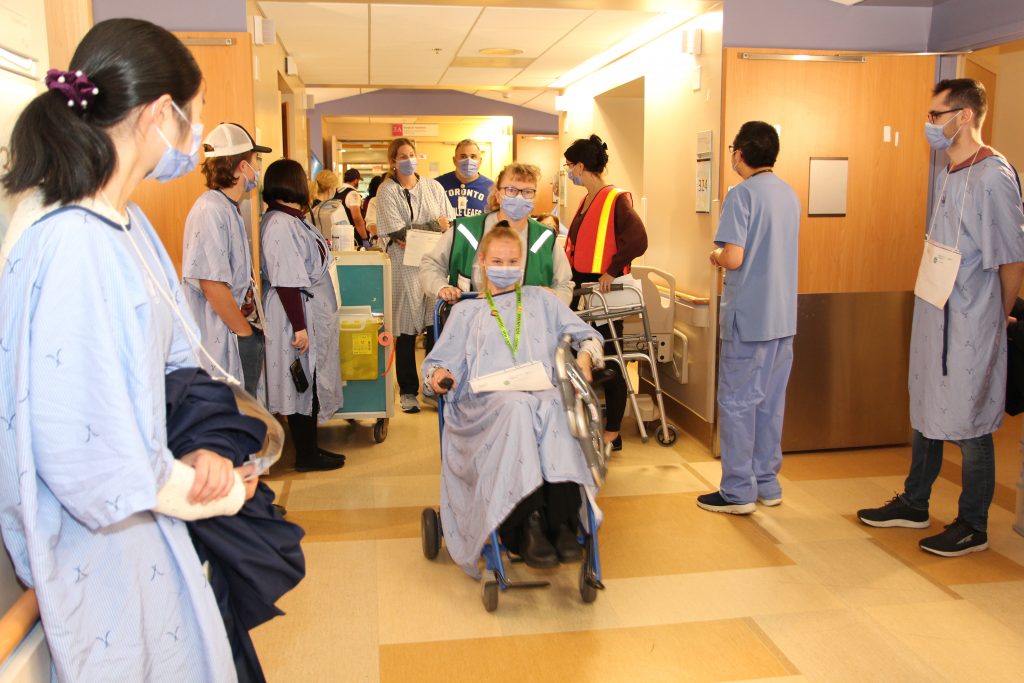Annual Drill Evaluates Hospital’s Ability to Safely Evacuate Patients in an Emergency
by Raiili Pellizzari
 This year we had 38 volunteers, the largest number of participants since pre-pandemic drills.
This year we had 38 volunteers, the largest number of participants since pre-pandemic drills.“Be prepared” may be the Scout’s motto, but it works for Thunder Bay Regional Health Sciences Centre (TBRHSC) as well.
This past fall, TBRHSC Emergency Preparedness led the coordination of a Minimum Staffing Drill (also referred to as a Vulnerable Occupancy Drill) with representation from the Hospital’s the Code Red (fire) and Code Green (evacuation) policy working groups and unit management. This annual hospital-wide drill, mandated by the Ontario Fire Code, tests the Hospital’s ability to safely evacuate patients from a unit during hours with minimal staffing levels. The team’s drill response is then evaluated and timed by Thunder Bay Fire Rescue (TBFR).
The drill was conducted with conditions adjusted to replicate times of minimal staffing, with volunteers acting as mock patients. A pre-determined fire alarm was triggered within the 3A Surgery department, prompting the activation of a hospital-wide Code Red response. The simulated scenario ultimately escalated, initiating a Code Green. Designated responders quickly arrived from across the Hospital as soon as the overhead announcement was made.
“This year we had 38 volunteers, the largest number of participants since pre-pandemic drills,” explains Mēsha Richard, Emergency Preparedness Lead. “All mock patients were evacuated within the mandated time. Immediately after the drill was completed, participants and observers, including TBFR, conducted a debrief to provide feedback. This was a great opportunity to discuss potential revisions of current emergency response plans and procedures, as well as improvements regarding exercise design and coordination.”
Brittney McLaughlin, Interprofessional Educator, supported the design and facilitation of the drill, as well as co-lead the debrief.
“Drills are a chance to promote interprofessional teamwork, and ultimately enhance the quality of patient care,” says McLaughlin. “It was great to see everyone actively engaged in this learning opportunity.”
Laura Jurimae, Manager, 3A and Mike Martin, Administrative Manger 3A, 3B, 3C and Neurosurgery Units, acted as observers during the drill.
“There is quite a lot of planning that goes into these drills,” explains Martin. “Laura and I helped with the preparation by coordinating volunteers, staff, and resources. This exercise provides a unique opportunity for our staff, volunteers, and partners in the community to practice for unexpected events.”
Jurimae adds, “The drill was a great success and allowed our staff to showcase their abilities with respect to emergency preparedness. We are very pleased with how smoothly everything went.”
“A big thank you to all of our staff and volunteers for their participation and commitment to emergency preparedness at TBRHSC. Looking forward to continuing to work together on training opportunities in 2024,” concludes Richard.
For more information on emergency preparedness at TBRHSC please visit https://bit.ly/emergency-codes-TBRHSC. If you’d like to become a volunteer with us please visit https://bit.ly/become-a-volunteer-TBRHSC.